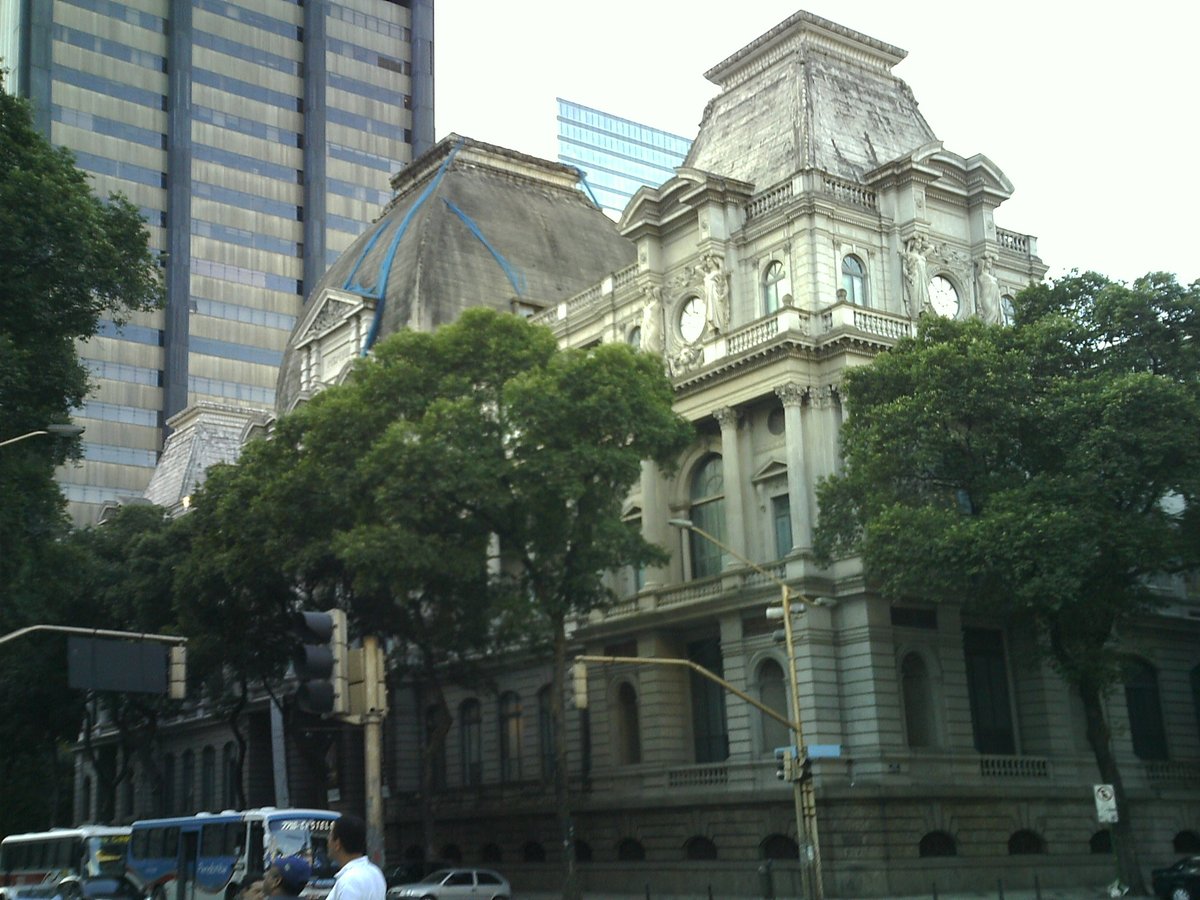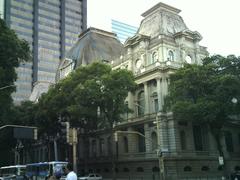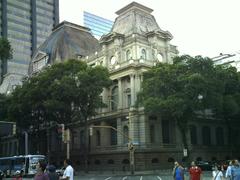
Complete Guide to Museu Nacional de Belas Artes: Visiting Hours, Tickets, and Rio de Janeiro Historical Sites
Date: 14/06/2025
Introduction
Nestled in the vibrant heart of Rio de Janeiro, the Museu Nacional de Belas Artes (MNBA) stands as a beacon of Brazil’s rich artistic and cultural heritage. Housed in a magnificent early 20th-century building and officially established in 1937, the MNBA is not only a repository of exceptional art but also a symbol of Brazil’s evolving national identity. This guide provides a comprehensive overview of the museum’s history, architectural significance, collection highlights, visitor information, and nearby attractions—offering essential details to help you plan an enriching visit to one of Rio de Janeiro’s premier cultural institutions (Diário do Rio; Britannica).
Historical Foundations and Institutional Evolution
The origins of the MNBA trace back to 1816, with the founding of the Escola Real de Ciências, Artes e Ofícios by King João VI of Portugal. This institution, pivotal in the development of Brazilian academic art, eventually evolved into the Escola Nacional de Belas Artes. Over time, the collection grew through royal patronage, acquisitions, and the legacy of the Imperial Academy of Fine Arts. The museum’s current building, designed by Adolfo Morales de los Ríos, was inaugurated in 1908 as part of Rio’s Belle Époque modernization and officially became the MNBA in 1937 (Diário do Rio; My Art Guides).
The museum’s institutional separation from the Escola de Belas Artes in the 1970s led to the MNBA retaining the majority of the art collection, while the school moved to the Federal University of Rio de Janeiro campus. The MNBA remains a national heritage site, recognized for its role in the preservation and promotion of Brazilian art (Wikipedia).
Architectural Significance and Urban Context
The MNBA building is a landmark of early 20th-century eclectic architecture, blending neoclassical, Renaissance revival, Baroque, and Beaux-Arts elements. Located on Avenida Rio Branco, it forms part of a cultural hub alongside the Theatro Municipal and Biblioteca Nacional. The façade features French Renaissance-inspired frontons, terracotta reliefs, and mosaics honoring figures such as Vitruvius and Leonardo da Vinci, while the interiors boast marble, mosaics, and ornate woodwork (História das Artes).
In 1973, the building was designated a national heritage site by IPHAN, ensuring its preservation for future generations. The museum’s architecture itself is a draw for visitors interested in history and design (Diário do Rio).
Artistic Significance and Collection Highlights
Home to over 70,000 works, the MNBA is considered Brazil’s foremost repository of 19th-century Brazilian art and one of the largest in Latin America (Wikipedia). The collection spans from colonial-era religious art and imperial portraits to modernist and contemporary works. Notable highlights include:
- Victor Meirelles: “Primeira Missa no Brasil” and “Batalha dos Guararapes”
- Pedro Américo: “Batalha do Avaí”
- Cândido Portinari: “Café”
- Tarsila do Amaral, Di Cavalcanti, Eliseu Visconti, and other modernists
- European Art: Works from the Renaissance to the 19th century, including Jean-Baptiste Debret’s illustrations of 19th-century Brazilian life
- African Art: Masks, sculptures, and ritual objects reflecting Brazil’s cross-cultural heritage (Google Arts & Culture; Rio de Janeiro Blog)
The museum also features a monumental 130 m² tile panel by Djanira, celebrating Saint Barbara, and extensive collections of prints, drawings, decorative arts, and folk artifacts.
Recent Developments and Restoration
Since 2020, the MNBA has been undergoing its most extensive restoration, aimed at preserving the building’s architectural features and modernizing facilities to meet international museological standards. Over 90% of the work is complete as of mid-2025, with a full reopening anticipated by the end of the year (Agência Brasil; Extra Globo). The renovations will enhance accessibility, update exhibition spaces, and improve visitor amenities.
Visitor Information
Location
- Address: Avenida Rio Branco, 199 – Centro, Rio de Janeiro, CEP: 20040-008 (Arttere)
- Neighborhood: Cinelândia, within Rio’s historic Centro district
Accessibility
- Public Transport: Easily accessible via Cinelândia metro station and several bus lines (Tourb)
- Wheelchair Access: Ramps, elevators, and adapted restrooms are available
- Other Services: Cloakroom, museum shop, café, and modern restrooms
Opening Hours and Admission (to be confirmed upon reopening)
- Usual Hours: Tuesday to Friday, 10:00 AM – 6:00 PM; Weekends/Holidays, 12:00 PM – 5:00 PM (WhichMuseum)
- Admission Fees: R$8 full, R$4 reduced (students, seniors). Free on Tuesdays. Audio guides available for an additional fee (Lonely Planet)
- Tickets: Purchase onsite or via the official website
Visitor Tips
- Recommended Visit Duration: Plan for 2–3 hours to explore the galleries and special exhibitions (TripHobo)
- Guided Tours: Available in Portuguese, English, and Spanish; booking in advance is advisable
- Photography: Non-flash photography is generally allowed, but restrictions may apply for some exhibitions
- Language: Most signage is in Portuguese; audio guides and select materials are available in English
Educational and Conservation Initiatives
The MNBA offers robust educational programming, including art history courses, workshops, and guided tours for all ages. Its conservation labs ensure the ongoing preservation of the museum’s vast collection (História das Artes).
Digital Access and Virtual Tours
While restoration continues, parts of the collection remain accessible online through Google Arts & Culture, featuring virtual tours and high-quality images.
Nearby Attractions
The MNBA’s prime location allows for easy exploration of other cultural landmarks:
- Theatro Municipal: Rio’s iconic opera house (Lonely Planet)
- Biblioteca Nacional: Latin America’s largest library
- Centro Cultural Justiça Federal: Historic cultural venue
- Passeio Público: Rio’s oldest public park
Frequently Asked Questions (FAQ)
Q: When will the MNBA reopen?
A: The museum expects to reopen by the end of 2025 after restoration (Agência Brasil).
Q: How can I buy tickets?
A: Tickets will be available at the entrance and online through the official website.
Q: Is the museum accessible?
A: Yes, with ramps, elevators, and adapted restrooms.
Q: Are guided tours available?
A: Yes, in multiple languages; check the website for details.
Q: Can I take photos inside the museum?
A: Non-flash photography is generally permitted; some exhibitions may restrict it.
Conclusion
The Museu Nacional de Belas Artes is more than a museum—it is a vibrant symbol of Brazilian cultural identity, history, and artistic achievement. Its impressive collection and grand architecture offer visitors a unique journey through Brazil’s past and present. As it prepares to reopen with renewed facilities and enhanced accessibility, the MNBA promises to reaffirm its place as a radiant hub of Brazilian art and a must-visit Rio de Janeiro historical site.
For the latest information on reopening, tickets, and special exhibitions, consult the official MNBA website and follow the museum on social media. Download the Audiala app for guided tours and to enrich your cultural journey in Rio de Janeiro.
References and Further Reading
- Diário do Rio
- Britannica
- My Art Guides
- História das Artes
- Wikipedia (PT)
- Google Arts & Culture
- Rio de Janeiro Blog
- Agência Brasil
- Lonely Planet
- WhichMuseum
- Extra Globo
- Arttere
- Tourb
- TripHobo





















































